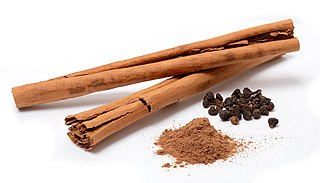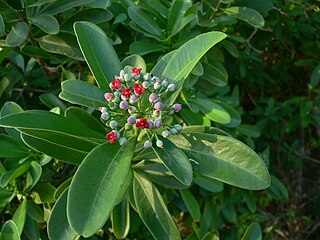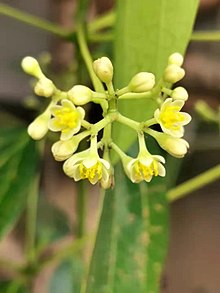
Cinnamon is a spice obtained from the inner bark of several tree species from the genus Cinnamomum. Cinnamon is used mainly as an aromatic condiment and flavouring additive in a wide variety of cuisines, sweet and savoury dishes, breakfast cereals, snack foods, bagels, teas, hot chocolate and traditional foods. The aroma and flavour of cinnamon derive from its essential oil and principal component, cinnamaldehyde, as well as numerous other constituents including eugenol.

Lauraceae, or the laurels, is a plant family that includes the true laurel and its closest relatives. This family comprises about 2850 known species in about 45 genera worldwide. They are dicotyledons, and occur mainly in warm temperate and tropical regions, especially Southeast Asia and South America. Many are aromatic evergreen trees or shrubs, but some, such as Sassafras, are deciduous, or include both deciduous and evergreen trees and shrubs, especially in tropical and temperate climates. The genus Cassytha is unique in the Lauraceae in that its members are parasitic vines. Most laurels are highly poisonous.

Malabathrum, malabathron, or malobathrum is the name used in classical and medieval texts for certain cinnamon-like aromatic plant leaves and an ointment prepared from those leaves. Cinnamomum tamala, grown most commonly in the eastern Himalayas, but also in the Western Ghats, is thought to be a notable source of these leaves, although other species of Cinnamomum and even plants in other genera may have been used. In ancient Greece and Rome, the leaves were used to prepare a fragrant oil, called oleum malabathri, and were therefore valuable.

Camphora officinarum is a species of evergreen tree that is commonly known under the names camphor tree, camphorwood or camphor laurel.

Cinnamomum tamala, Indian bay leaf, also known as tejpat, tejapatta,Malabar leaf, Indian bark, Indian cassia, or malabathrum, is a tree in the family Lauraceae that is native to India, Bangladesh, Nepal, Bhutan, and China. It can grow up to 20 m (66 ft) tall. Its leaves have a clove-like aroma with a hint of peppery taste; they are used for culinary and medicinal purposes. It is thought to have been one of the major sources of the medicinal plant leaves known in classic and medieval times as malabathrum.

Saigon cinnamon is an evergreen tree indigenous to mainland Southeast Asia. Saigon cinnamon is more closely related to cassia than to Ceylon cinnamon, though in the same genus as both. Saigon cinnamon has 1-5% essential oil content and 25% cinnamaldehyde in essential oil. Consequently, among the species, Saigon cinnamon commands a relatively high price.

Graphium sarpedon, the common bluebottle or blue triangle in Australia, is a species of swallowtail butterfly that is found in South and Southeast Asia, as well as eastern Australia. There are approximately sixteen subspecies with differing geographical distributions.

Cinnamomum burmanni, also known as Indonesian cinnamon, Padang cassia, Batavia cassia, or korintje, is one of several plants in the genus Cinnamomum whose bark is sold as the spice cinnamon. It is an evergreen tree native to southeast Asia.

Cinnamomum osmophloeum, commonly known as pseudocinnamomum or indigenous cinnamon, is a medium-sized evergreen tree in the genus Cinnamomum. It is native to broad-leaved forests of central and northern Taiwan.

Canella is a monospecific genus containing the species Canella winterana, a tree native to the Caribbean from the Florida Keys to Barbados. Its bark is used as a spice similar to cinnamon, giving rise to the common names cinnamon bark, wild cinnamon, and white cinnamon.

Cinnamomum verum is a small evergreen tree belonging to the family Lauraceae, native to Sri Lanka. The inner bark of the tree is historically regarded as the 'spice' cinnamon, though this term was later generalized for both C. cassia and C. zeylanicum as well.
Dodecadenia is a botanical genus of flowering plants in the family Lauraceae. It contains a single species, Dodecadenia grandiflora. It is present from central Asia, to Himalayas and India. It is present in tropical and subtropical montane rainforest, laurel forest, in the weed-tree forests in valleys, mixed forests of coniferous and deciduous broad-leaved trees, Tsuga forests; 2,000–2,600 metres (6,600–8,500 ft) in China in provinces of Sichuan, Xizang, Yunnan, and countries of Bhutan, India, Myanmar, and Nepal.

Camphora glandulifera, common name false camphor tree or Nepal camphor tree, is a tree in the genus Cinnamomum of the family Lauraceae.
Syndiclis is a genus of flowering plants in the family Lauraceae. It contains ten species, which are native to China, Vietnam and Hainan, and Bhutan.

Cinnamomum mercadoi (kalingag) is a small tree, about 6 to 10 metres high, with a thick, aromatic bark. The plant part of the family Lauraceae, which contains about 45 genera and 2000-2500 species, and is related to the culinary cinnamon, sassafras, and bay tree. The plant is indigenous to the Philippines, where it grows best in forests at low and medium altitudes that sometimes ascend to 2,000 metres (6,600 ft). C. mercadoi is unusual in the cinnamon family in that its essential oil consists large amounts of safrol, whereas other oils of cinnamon contain cinnamaldehyde. It is currently listed in the International Union for Conservation of Nature (IUCN) Red List as "vulnerable" due to the overharvesting and the continuous loss of the Philippine forests.

Cinnamomum kanehirae, also known as small-flowered camphor tree, or stout camphor tree, is a tree within the genus Cinnamomum of the family Lauraceae endemic to Taiwan.

Cinnamomum malabatrum, wild cinnamon, country cinnamon also known as malabathrum, is a tree in the family Lauraceae that is endemic to Western Ghats of India. It can grow up to 15 m (49 ft) tall. It has aromatic leaves that are used for culinary and medicinal purposes. It is thought to have been one of the major sources of the medicinal plant leaves known in classic and medieval times as malabathrum. It is locally known as Edana, Therali or Vazhana in Kerala.

Camphora is a genus of evergreen plants belonging to the laurel family, Lauraceae. The genus contains approximately 20 species, distributed in tropical and subtropical regions of Asia. This genus was previously considered a synonym of Cinnamomum.
Cinnamomum bodinieri is a species of flowering plant in the family Lauraceae, native to southern China. A tree reaching 16 m (52 ft), it is typically found in situations with more light, such as alongside roads and streams or in open forests and thickets. Its essential oil is high in citral. It is used as a street tree in a number of southern Chinese cities.





















